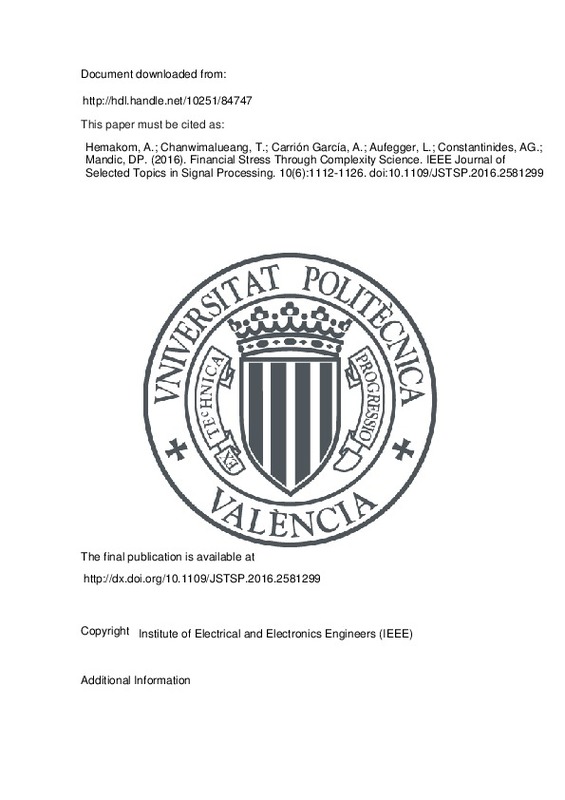JavaScript is disabled for your browser. Some features of this site may not work without it.
Buscar en RiuNet
Listar
Mi cuenta
Estadísticas
Ayuda RiuNet
Admin. UPV
Financial Stress Through Complexity Science
Mostrar el registro sencillo del ítem
Ficheros en el ítem
| dc.contributor.author | Hemakom, Apit
|
es_ES |
| dc.contributor.author | Chanwimalueang, Theerasak
|
es_ES |
| dc.contributor.author | Carrión García, Alicia
|
es_ES |
| dc.contributor.author | Aufegger, Lisa
|
es_ES |
| dc.contributor.author | Constantinides, Anthony G.
|
es_ES |
| dc.contributor.author | Mandic, Danilo P.
|
es_ES |
| dc.date.accessioned | 2017-07-07T12:07:12Z | |
| dc.date.available | 2017-07-07T12:07:12Z | |
| dc.date.issued | 2016-09 | |
| dc.identifier.issn | 1932-4553 | |
| dc.identifier.uri | http://hdl.handle.net/10251/84747 | |
| dc.description.abstract | Financial markets typically undergo periods of prosperity followed by periods of stagnation, and this undulation makes it challenging to maintain market efficiency. The efficient market hypothesis (EMH) states that there exist differences in structural complexity in security prices between regular and abnormal situations. Yet, despite a clear link between market acceleration (cf. recession in security prices) and stress in physical systems, indices of financial stress still have significant scope for further development. The overarching aim of this work is therefore to determine the characteristics of financial indices related to financial stress, and to establish a robust metric for the extent of such 'stress'. This is achieved based on intrinsic multiscale analysis which quantifies the so called complexity-loss hypothesis in the context of financial stress. The multiscale sample entropy and our proposed Assessment of Latent Index of Stress methods have successfully assessed financial stress, and have served as a measure to establish an analogy between transitions from 'normal' (relaxed) to 'abnormal' (stressed) financial periods with the sympatho-vagal balance in humans. Four major stock indices of the US economy over the past 25 years are considered: (i) Dow Jones Industrial Average, (ii) NASDAQ Composite, (iii) Standard & Poor's 500, and (iv) Russell 2000, together with FTSE 100, CAC 40 and exchange rates. Our findings support the EMH theory and reveal high stress for both the periods of Internet bubble burst and sub-prime mortgage crisis. | es_ES |
| dc.description.sponsorship | This work was supported by the Financial Signal Processing Laboratory (http://www.fsplab.com/) at Imperial College London. The guest editor coordinating the review of this manuscript and approving it for publication was Prof. Ali N. Akansu. | en_EN |
| dc.language | Inglés | es_ES |
| dc.publisher | Institute of Electrical and Electronics Engineers (IEEE) | es_ES |
| dc.relation.ispartof | IEEE Journal of Selected Topics in Signal Processing | es_ES |
| dc.rights | Reserva de todos los derechos | es_ES |
| dc.subject | Assessment of Latent Index of Stress (ALIS) index | es_ES |
| dc.subject | Complexity-loss hypothesis | es_ES |
| dc.subject | Determinism | es_ES |
| dc.subject | Financial stress | es_ES |
| dc.subject | Intrinsic phase synchrony (IPS) | es_ES |
| dc.subject | Multiscale entroypy | es_ES |
| dc.subject | Nonlinearity | es_ES |
| dc.subject.classification | TEORIA DE LA SEÑAL Y COMUNICACIONES | es_ES |
| dc.title | Financial Stress Through Complexity Science | es_ES |
| dc.type | Artículo | es_ES |
| dc.identifier.doi | 10.1109/JSTSP.2016.2581299 | |
| dc.rights.accessRights | Abierto | es_ES |
| dc.contributor.affiliation | Universitat Politècnica de València. Instituto Universitario de Telecomunicación y Aplicaciones Multimedia - Institut Universitari de Telecomunicacions i Aplicacions Multimèdia | es_ES |
| dc.description.bibliographicCitation | Hemakom, A.; Chanwimalueang, T.; Carrión García, A.; Aufegger, L.; Constantinides, AG.; Mandic, DP. (2016). Financial Stress Through Complexity Science. IEEE Journal of Selected Topics in Signal Processing. 10(6):1112-1126. doi:10.1109/JSTSP.2016.2581299 | es_ES |
| dc.description.accrualMethod | S | es_ES |
| dc.relation.publisherversion | http://dx.doi.org/10.1109/JSTSP.2016.2581299 | es_ES |
| dc.description.upvformatpinicio | 1112 | es_ES |
| dc.description.upvformatpfin | 1126 | es_ES |
| dc.type.version | info:eu-repo/semantics/publishedVersion | es_ES |
| dc.description.volume | 10 | es_ES |
| dc.description.issue | 6 | es_ES |
| dc.relation.senia | 328466 | es_ES |
| dc.contributor.funder | Imperial College London | es_ES |







![[Cerrado]](/themes/UPV/images/candado.png)

